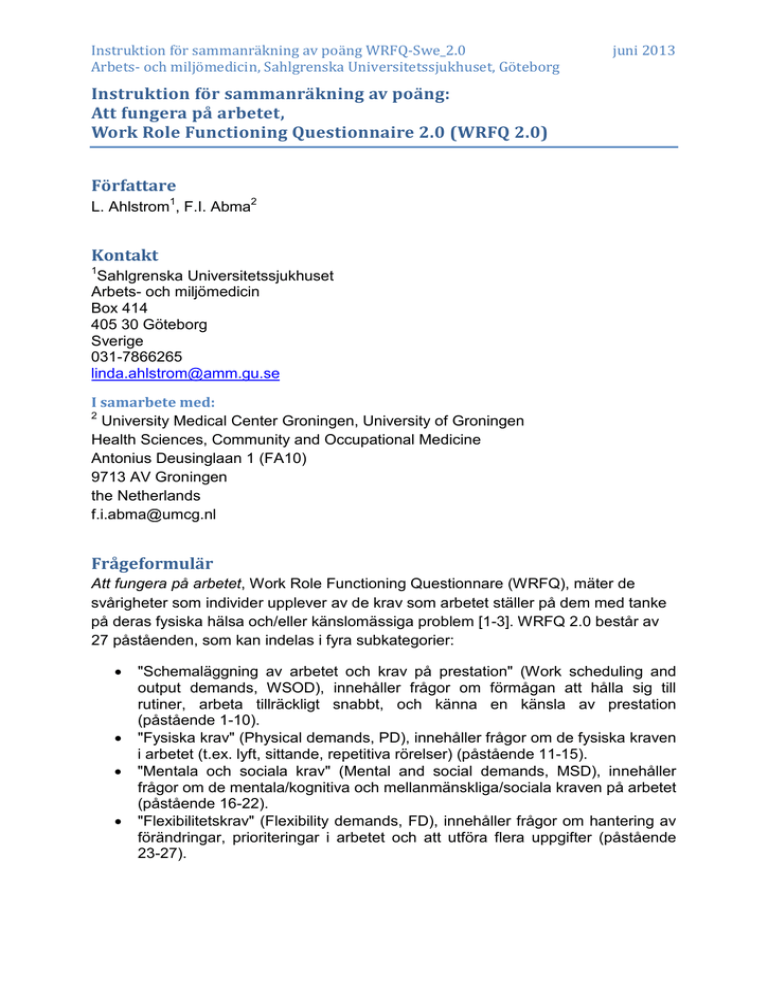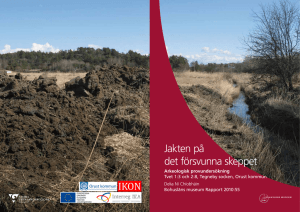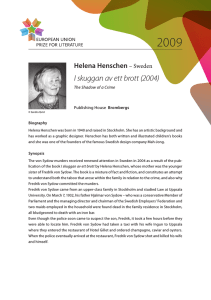Manual - Fhvmetodik.se
advertisement

Instruktion för sammanräkning av poäng WRFQ-Swe_2.0 Arbets- och miljömedicin, Sahlgrenska Universitetssjukhuset, Göteborg Instruktion för sammanräkning av poäng: Att fungera på arbetet, Work Role Functioning Questionnaire 2.0 (WRFQ 2.0) juni 2013 Författare L. Ahlstrom1, F.I. Abma2 Kontakt 1 Sahlgrenska Universitetssjukhuset Arbets- och miljömedicin Box 414 405 30 Göteborg Sverige 031-7866265 linda.ahlstrom@amm.gu.se I samarbete med: 2 University Medical Center Groningen, University of Groningen Health Sciences, Community and Occupational Medicine Antonius Deusinglaan 1 (FA10) 9713 AV Groningen the Netherlands f.i.abma@umcg.nl Frågeformulär Att fungera på arbetet, Work Role Functioning Questionnare (WRFQ), mäter de svårigheter som individer upplever av de krav som arbetet ställer på dem med tanke på deras fysiska hälsa och/eller känslomässiga problem [1-3]. WRFQ 2.0 består av 27 påståenden, som kan indelas i fyra subkategorier: • • • • "Schemaläggning av arbetet och krav på prestation" (Work scheduling and output demands, WSOD), innehåller frågor om förmågan att hålla sig till rutiner, arbeta tillräckligt snabbt, och känna en känsla av prestation (påstående 1-10). "Fysiska krav" (Physical demands, PD), innehåller frågor om de fysiska kraven i arbetet (t.ex. lyft, sittande, repetitiva rörelser) (påstående 11-15). "Mentala och sociala krav" (Mental and social demands, MSD), innehåller frågor om de mentala/kognitiva och mellanmänskliga/sociala kraven på arbetet (påstående 16-22). "Flexibilitetskrav" (Flexibility demands, FD), innehåller frågor om hantering av förändringar, prioriteringar i arbetet och att utföra flera uppgifter (påstående 23-27). Instruktion för sammanräkning av poäng WRFQ-Swe_2.0 Arbets- och miljömedicin, Sahlgrenska Universitetssjukhuset, Göteborg Poängberäkning juni 2013 De 27 påståendena besvaras i procent av tiden som individen upplevt svårigheter när han/hon utfört sina arbetsuppgifter och med tanke på de arbetskrav som ställs på honom/henne. Svar anges med 0 = svårt hela tiden (100%), 1 = svårt det mesta av tiden, 2 = svårt hälften av tiden (50%), 3 = svårt en del av tiden, 4 = svårt ingen del av tiden (0%). Det finns ett svarsalternativ som är "Gäller inte mitt jobb". Poängen på "Gäller inte mitt jobb" transformeras till saknade värden (missing) [4,5]. Den totala poängen Den totala poängen beräknas genom att summera alla svar dividerat med antalet besvarade påståenden (oftast 27, kan vara lägre på grund av saknade värden). Värdet multipliceras med 25 för att erhålla procenttal mellan 0% och 100%, högre poäng indikerar att arbetet fungerar bättre. Om mer än 20% av påståendena saknas kan inga poäng beräknas och resultatet sätts till saknas. Resultatet blir 0-100%, ju högre poäng desto bättre funktion i arbetet. Beräkning av subkategorier Subkategorier beräknas genom att poängen från påståendena tillhörande den subkategorin summeras, dividerat med antalet besvarade påståenden i underskalan. Svaret multipliceras med 25 för att erhålla procenttal mellan 0 och 100. Högre poäng är en indikation på att arbetet fungerar. Om mer än 20% av påståendena saknas kan inga poäng beräknas och resultatet sätts till saknas. Validering av instrumentet En valideringsstudie av instrumentet WRFQ 2.0 har gjorts på den nederländska versionen. Den svenska valideringen av instrumentet är påbörjad och kommer inom en snar framtid att publiceras. På nästa sida kommer information om den nederländska versionen och dess validering, skriven på engelska. Instruktion för sammanräkning av poäng WRFQ-Swe_2.0 Arbets- och miljömedicin, Sahlgrenska Universitetssjukhuset, Göteborg Measurement properties juni 2013 A validation study was conducted in the general working population in the Netherlands to evaluate the measurement properties of the WRFQ 2.0. In total 553 workers completed the WRFQ 2.0 and were included in the analyses. All participants were working more than 12 hours/wk and almost 90% had a good to excellent selfrated health (measured with the general health items from the SF12). Interpretability and Cronbach’s alphas Table 1 – WRFQ 2.0 description in the general working population Valid N (missing or ‘not applicable’) 545 (8) Mean (SD) Work scheduling & 81.8 (19.8) Output demands (WSOD) Physical demands 381 (172) 87.1 (19.6) (PD) Mental & Social 543 (10) 85.2 (17.5) demands (MSD) Flexibility demands 519 (34) 84.0 (20.7) (FD) Total score 535 (18) 84.2 (15.8) Alphas calculated in SPSS (listwise deletion) Range (0-100) Cronbach’s α 5-100 N (%) at N (%) at floor (0%) ceiling (100%) 0 (0.0%) 88 (16.1%) 0-100 1 (0.3%) 185 (48.6%) 0.92 0-100 1 (0.2%) 154 (28.4%) 0.93 0-100 10 (1.9%) 153 (29.5%) 0.91 5.8-100 0 (0.0%) 45 (8.4%) 0.96 0.92 Table 2 – WRFQ 2.0 job type and health status subgroup scores Work scheduling & Output demands (WSOD) Physical demands (PD) Mental & Social demands (MSD) Flexibility demands (FD) Total score Manual Mean (SD) (N=155) Non-manual Mean (SD) (N=262) 84.1 (17.7) Good-excellent health Mean (SD) (N=479) 82.7 (19.0) Poor-fair health Mean (SD) (N=59) 73.7 (23.7) 82.7 (22.5) 81.8 (20.6) 93.0 (15.8) 88.8 (17.9) 74.7 (26.7) 86.8 (21.5) 86.8 (14.5) 86.5 (15.6) 75.6 (25.3) 83.7 (27.2) 86.5 (17.2) 84.9 (20.0) 76.1 (24.8) 84.1 (18.9) 86.8 (12.8) 85.2 (14.7) 75.5 (21.5) Reliability For the WRFQ 2.0 total score an ICC of 0.66 (95%CI: 0.54-0.76) was calculated. The ICCs for the subscales were respectively: WSOD=0.63; PD=0.82; MSD=0.61 and FD=0.29. The standard error of measurement (SEM) for the WRFQ 2.0 total score Instruktion för sammanräkning av poäng WRFQ-Swe_2.0 Arbets- och miljömedicin, Sahlgrenska Universitetssjukhuset, Göteborg juni 2013 was 7.89. The SEMs for the subscales were respectively: WSOD=13.22; PD=7.51; MSD=8.69 and FD=14.94. [4] Construct validity Ten hypotheses were formulated and tested of which nine were (partly) confirmed, providing evidence for the construct validity of the WRFQ-DV. The WRFQ-DV is able to distinguish between groups with high/low levels of mental health, physical health, fatigue and need for recovery. A moderate correlation was found between WRFQ-DV and related constructs respectively work ability (r=0.47) and work productivity (r=0.49). A weak relationship was found with general self-rated health, work engagement and work involvement.[5] Responsiveness A total of N=98 participants completed the 3 month follow-up questionnaire. Participants were classified based on three measures of change (based on health status, work and work ability) in ‘changed’ versus ‘not changed’ groups. A large majority of the participants reported no change on all three measures of change, resulting in very small groups that reported change. The groups were too small to conduct valid analyses. This resulted in poor-to-moderate responsiveness. Further research is needed to examine responsiveness of the WRFQ 2.0.[4] Use of WRFQ 2.0 The WRFQ 2.0 appears to be a reliable and valid instrument for use in research to measure health-related work functioning. The instrument is updated to the current world of work. The WRFQ 2.0 might be a helpful tool in the concerted action of the occupational health care professionals and the human resources professionals. The instrument can be used as input for a conversation between the occupational health care professional, HRM professional and/or worker about the actual functioning of the worker, without over-medicalizing the situation. In addition, the instrument provides detailed information about which aspects of the job demands are difficult to meet for the worker, e.g. providing directions for job accommodation. Based on the validation study results the instrument is able to detect differences between workers with respectively low and high physical and mental health, fatigue and need for recovery. For application in practice it is important for professionals to take the intended use in mind and should be careful when interpreting the results. Caution is needed when the measurement properties are not studied or unclear when needed for that intended use. For example, if the aim is to start a conversation, there is no problem expected. If the aim is to evaluate an intervention or diagnose a worker, caution is warranted. Validating an instrument is an ongoing process and is never finished. Additional research is needed to further examine the measurement properties of the WRFQ 2.0, especially for use in practice. Instruktion för sammanräkning av poäng WRFQ-Swe_2.0 Arbets- och miljömedicin, Sahlgrenska Universitetssjukhuset, Göteborg Referenser juni 2013 [1] Amick BC,III, Lerner D, Rogers WH, Rooney T, Katz JN. A review of health-related work outcome measures and their uses, and recommended measures. Spine 2000;25(24):31523160. [2] Amick BC,III, Habeck RV, Ossmann J, Fossel AH, Keller R, Katz JN. Predictors of successful work role functioning after carpal tunnel release surgery. J Occup Environ Med 2004 05;46(1076-2752; 5):490-500. [3] Abma FI, Amick BC,3rd, Brouwer S, van der Klink JJL, Bultmann U. The cross-cultural adaptation of the Work Role Functioning Questionnaire to Dutch. Work: Journal of Prevention, Assessment & Rehabilitation In press. [4] Abma FI, Bültmann U, van der Klink JJL. The Work Role Functioning Questionnaire 2.0: Reliability, Validity and Responsiveness in the general working population. Submitted. [5] Abma FI, van der Klink JJL, Bültmann U. Construct validity of the Work Role Functioning Questionnaire 2.0: Relations with health status, work and workability. Submitted.






![The battle of Narva [pdf]](http://s2.studylib.net/store/data/005291474_1-7b7f518db87cf6fa9dca127aaa7c6b6f-300x300.png)




